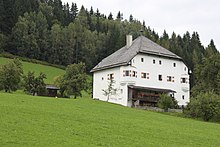Judenhof residence
The Judenhof residence (formerly called Judendorf ) is located in the March district of the Goldegg im Pongau community in the St. Johann im Pongau district of Salzburg (March 1).
The settlements in the Salzburg region called Judendorf were on old trade routes that crossed the Alps (another Judendorf was in Fusch on the Großglocknerstrasse ). One can assume that these were branches of Jewish merchants who were involved in the trade in goods in the early Middle Ages. In the Goldegg area, too, the path from Sankt Veit im Pongau passed the Judendorf in close proximity. In 1553, however, the road between Schwarzach and Lend (then Hirschfurt ) was built through the Salzach Valley and the Judendorf residence was now far from the new trade route. In the 17th century the name Judendorf was removed and changed to Judenhof .
history
The residence was an archiepiscopal knightly fief of Konrad Prünlinger, it was first mentioned in 1429 ( Ain Hof called datz Judendorf ). In 1441 the old Pründlinger is proven to be the owner, Konrad , and his son is his successor. In 1529 one half of the property was married to Peter Aman von Hundsdorf, the other half passed to his cousin Veit Aman von Saal in 1560 . This was previously Gerhab of the underage heirs of this fief half. In 1594, Sigmund Aman von Saal and Judendorf were able to reunite the property in one hand. In 1598 Veit Stöckl zu Schwarzegg acquired this rule. This was the Berchtesgadischer provost on the Heuberg and from then on called himself von Judendorf . His attempt to convert the property into a free property failed because of the Salzburg court chamber, which decided in 1619 that this Jewish court was not a frozen aristocratic seat ; In 1628 the Judenhof and all its taxes were placed under the district court of St. Veit . Adam Stöckl, Veit's son, sold the property to Absalom Mayrhofer in 1632.
This is followed by a long line of bourgeois and rural owners: Hans Schattauer (1638), Ruprecht Mayr (1641), the Zwaylinger family (1672–1746), Johann Paur (1746), Sebastian Jakober (1778), Josef Hochleitner (1803), Johann Linsinger (1820), the Hinterlechner family (1825–1922), Peter and Theresia Piberger (1922), Alois Bründl (1929), auctioned off to the Salzburg mortgage company, Hermann von Rautenberg (1938, renamed Sonnhof ) and Martha Kaiser (1959) ).
Judenhof residence today
The building is a typical residence for the Salzburg region . He has a cripple hipped roof . Two round corner bay windows face the street. Red-white-red painted shutters and z. Some of the wrought-iron window bars decorate the first floor. The building is vaulted inside . Part of its interior was destroyed in a fire in 1878; During the reconstruction, the two conical roofs of the corner bay windows disappeared. The best part of the interior, the so-called Goldegger Stube , came to the Salzburg museum in 1883 . This Zirbenholzstube was built in 1606 and was built into the Judenhof under Veit Stoss. It is 37.5 m² in size, the doors and the framing pilasters are decorated with rich inlays. The equipment consists of a table, chests set into the wall and benches connected to the wall as well as a tiled stove. The room is spanned by a heavenly coffered ceiling supported by consoles with carved angel heads, the evangelists and a devil-like creature.
It was open to the public in the Carolino Augusteum Museum until October 2005, but was moved to a depot after the old museum building was closed. It was put up again in 2016 as part of the state exhibition (“Tell me Salzburg”).
literature
- Friederike Zaisberger & Walter Schlegel : Castles and palaces in Salzburg. Pongau, Pinzgau, Lungau. Birch series, Vienna 1978, ISBN 3-85030-037-4 .
Individual evidence
- ↑ Judendorf
- ↑ Urd Valeske (2016): “Tell me about Salzburg!” Goldegger Stube in a new light. Salzburger Museumblätter, No. 3/4, volume 77, p. 6.
Web links
Coordinates: 47 ° 19 ′ 29.4 " N , 13 ° 5 ′ 33.2" E
